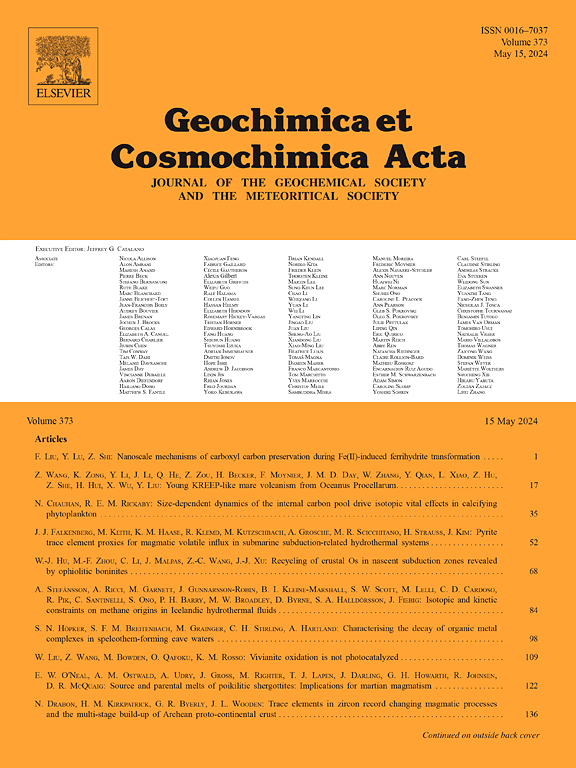Thallium isotope cycling in a ferruginous Precambrian ocean analogue
IF 4.5
1区 地球科学
Q1 GEOCHEMISTRY & GEOPHYSICS
引用次数: 0
Abstract
Precambrian oceans were overwhelmingly anoxic and rich in dissolved ferrous iron (Fe2+), conditions referred to as ‘ferruginous’. Yet, few paleoceanographic tools widely applied to the Precambrian sedimentary record are investigated in detail in the few available ferruginous settings today. We conducted a detailed thallium (Tl) isotope investigation of Deming Lake, a meromictic ferruginous lake in Itasca State Park (Minnesota, USA). Only slight changes were observed in dissolved Tl concentrations (Tldiss) and isotopic compositions (ε205Tldiss) between spring, summer, and winter months. This was despite the development of a winter ice cap, a dramatic shoaling of the oxycline, and large swings in dissolved and particulate Fe concentrations. Isotopic compositions of authigenic Tl (ε205TlA) leached from surface sediments across a shallow-to-deep gradient averaged –2.2 ± 0.9‱ (2SD) and were at all depths slightly lower than corresponding waters, which averaged 0.0 ± 1.3‱ (2SD). We estimate that the Tl isotope fractionation process responsible for driving this effect has an associated fractionation factor (α) of 0.9998 to 0.9999. Processes behind this fractionation could be preferential 203Tl removal by biomass and organic sulfur. Thallium removal from the uppermost water column during the spring and summer months had an associated α up to 1.0005, most likely due to the preferential sorption of 205Tl onto Mn oxide minerals. This process plays little to no role in setting sedimentary ε205TlA values, probably because Mn oxide minerals are unstable in sediments throughout the lake. We find no evidence of strongly coupled Tl and Fe cycling in Deming Lake, and by extension suspect that ferruginous conditions did not play an important direct role in ancient seawater Tl isotope mass-balance. What the lake does tell us, however, is that organic-rich and sulfur-poor sediments can slightly fractionate Tl isotopes. Ancient sediments formed under comparable conditions may be unreliable water column ε205Tl archives. And if these sediment types were widely distributed on the ancient seafloor, they could have exerted a minor effect on global seawater Tl isotope mass-balance. Our results provide novel insights into how Tl and its isotopes are cycled under ferruginous conditions, permitting more accurate application of the Tl isotope paleoredox proxy to the Precambrian sedimentary record.
前寒武纪含铁海洋类似物中的铊同位素循环
前寒武纪的海洋绝大多数是缺氧的,富含溶解的亚铁(Fe2+),这种条件被称为“含铁”。然而,很少有广泛应用于前寒武纪沉积记录的古海洋学工具在当今少数可用的含铁环境中进行了详细的研究。本文对美国明尼苏达州伊塔斯卡州立公园(Itasca State Park)德明湖(Deming Lake)的三分态含铁湖泊铊(Tl)同位素进行了详细的研究。春、夏、冬3个月间溶解Tl浓度(Tldiss)和同位素组成(ε205Tldiss)变化不大。尽管出现了冬季冰帽,氧跃层急剧变浅,溶解铁和颗粒铁浓度大幅波动,但这一结果仍然存在。自生Tl (ε205TlA)的同位素组成沿浅到深的梯度从表层沉积物中浸出,平均为-2.2±0.9‰(2SD),并且在所有深度都略低于相应水域的平均0.0±1.3‰(2SD)。我们估计驱动这一效应的Tl同位素分馏过程的相关分馏因子(α)为0.9998 ~ 0.9999。这种分馏过程背后的过程可能是生物质和有机硫优先去除203Tl。在春夏两季,最上层水柱的铊去除率α值高达1.0005,这很可能是由于205Tl优先吸附在锰氧化物矿物上所致。这一过程对沉积ε205TlA值的确定几乎没有作用,可能是由于整个湖的沉积物中锰氧化物矿物不稳定。我们没有发现在戴明湖中存在强耦合的Tl和Fe循环的证据,由此推测铁条件在古海水Tl同位素质量平衡中没有起重要的直接作用。然而,这个湖告诉我们的是,富含有机物和缺乏硫的沉积物可以轻微地分离出Tl同位素。在类似条件下形成的古沉积物可能是不可靠的水柱ε205Tl档案。如果这些沉积物类型广泛分布在古代海底,它们可能对全球海水Tl同位素质量平衡产生轻微影响。我们的研究结果为研究含铁条件下Tl及其同位素的循环提供了新的见解,允许更准确地将Tl同位素古氧化还原代理应用于前寒武纪沉积记录。
本文章由计算机程序翻译,如有差异,请以英文原文为准。
求助全文
约1分钟内获得全文
求助全文
来源期刊

Geochimica et Cosmochimica Acta
地学-地球化学与地球物理
CiteScore
9.60
自引率
14.00%
发文量
437
审稿时长
6 months
期刊介绍:
Geochimica et Cosmochimica Acta publishes research papers in a wide range of subjects in terrestrial geochemistry, meteoritics, and planetary geochemistry. The scope of the journal includes:
1). Physical chemistry of gases, aqueous solutions, glasses, and crystalline solids
2). Igneous and metamorphic petrology
3). Chemical processes in the atmosphere, hydrosphere, biosphere, and lithosphere of the Earth
4). Organic geochemistry
5). Isotope geochemistry
6). Meteoritics and meteorite impacts
7). Lunar science; and
8). Planetary geochemistry.
 求助内容:
求助内容: 应助结果提醒方式:
应助结果提醒方式:


